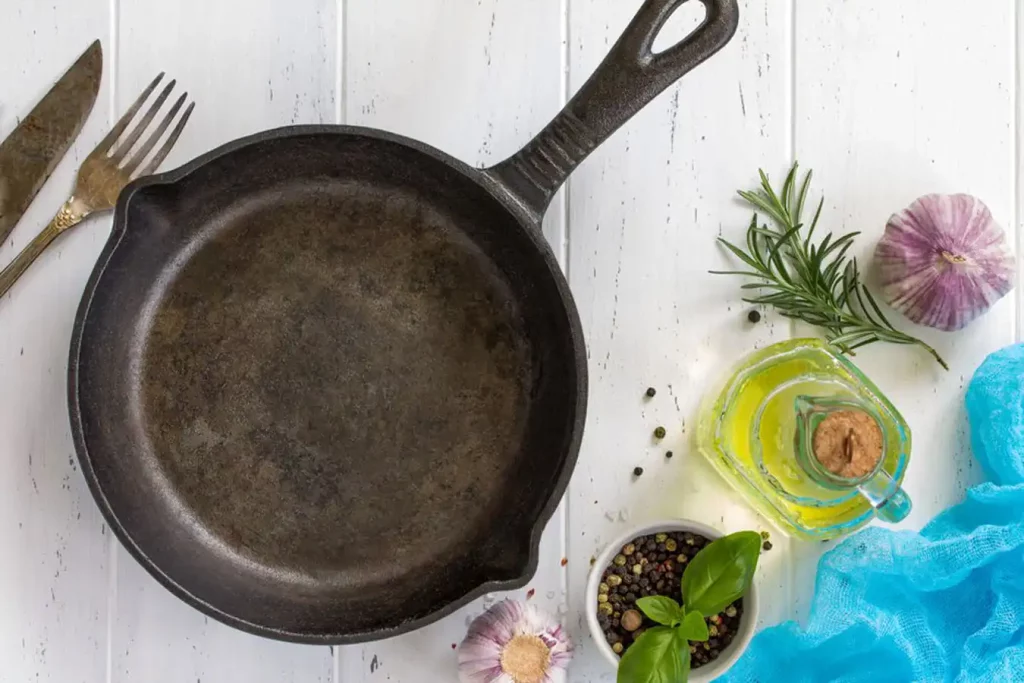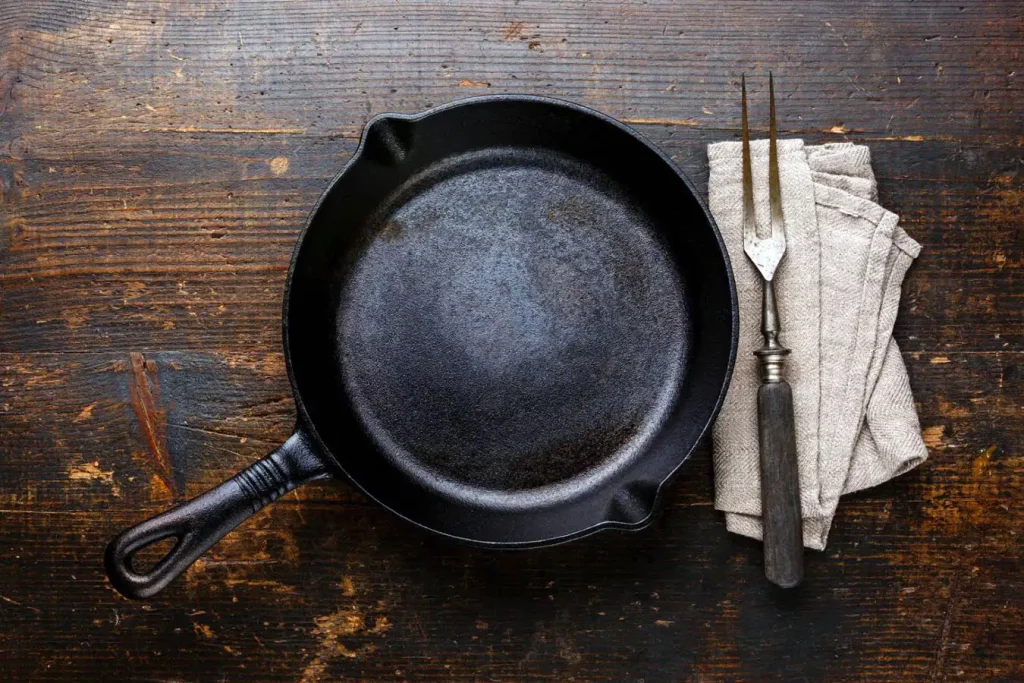Are you wondering how to season cast iron with grapeseed oil?
You’ve come to the right page!
As a fervent blogger and a seasoned outdoorsman, and in this article, I’m about to unveil my simple yet effective step-by-step guide.
Much like the unforgettable scent of campfire smoke and camp food, the practice of seasoning cast iron with grapeseed oil has a charm of its own, and I’m excited to help you experience it.
This tutorial will serve as your roadmap, leading you through the nuances of the process with the utmost clarity.
So, strap in and get ready to enhance your kitchen skills, as we embark on this flavorful journey together!
Understanding Cast Iron Seasoning
Now, before we get into the nitty-gritty, let’s take a moment to appreciate what seasoning means when it comes to cast iron skillets. It’s more than just a fancy cooking term – it’s the secret sauce that makes your cast iron skillet an irreplaceable tool in your kitchen or campsite.
The Role of Seasoning in Cast Iron Care
Seasoning isn’t about adding herbs and spices to your dish. In the context of cast iron care, seasoning refers to a process of applying oil to the surface of the skillet, then heating it to a high temperature. This creates a naturally non-stick layer, making the skillet easier to cook with and clean. This protective layer also prevents rust, extending the longevity of your beloved cast iron skillet. It’s like a trusted old friend – the more you care for it, the more it gives back.
Now you might be wondering why we’re specifically talking about grapeseed oil today. Good question! In my experience, grapeseed oil stands out from the crowd due to its high smoke point and neutral flavor, making it an excellent choice for seasoning your cast iron cookware.
The Science Behind Cast Iron Seasoning
Here’s a fun fact for you: the process of seasoning a cast iron skillet is actually a fascinating chemical reaction. As grapeseed oil heats up, it reaches a point known as the smoke point – the temperature at which it begins to break down and smoke. It’s at this point that a process called polymerization occurs. The oil transforms into a hard, slick coating that bonds with the surface of the iron. This coating, or patina, as it’s often called, is your non-stick layer. The more you use and properly maintain your skillet, the better this layer becomes. Now, isn’t that something?
Now that we’ve set the stage, our next step is to actually get into the process of seasoning your skillet with grapeseed oil.
Learn more: Season a Cast Iron Skillet With Bacon Grease
Why Choose Grapeseed Oil for Seasoning?
In the world of seasoning, oils are not created equal. Some are good, others are better, and then there’s grapeseed oil. The choice of oil can make a significant difference in the quality of the seasoning on your cast iron skillet. Grapeseed oil has some distinct qualities that make it a superior choice. Let’s delve into the reasons behind this.
Advantages of Grapeseed Oil
Grapeseed oil has been a secret weapon in my culinary adventures, and for good reason. First off, it has a high smoke point – about 420°F (216°C). This is a fancy way of saying it can handle a lot of heat before it starts to smoke, which is perfect for the high-temperature process of seasoning a cast iron skillet.

Secondly, it’s flavor-neutral. You don’t want your oil to affect the taste of your dishes, do you? Grapeseed oil ensures that the taste of your food remains untarnished.
Lastly, it has a light texture. This means it’s easy to spread evenly over the surface of your skillet, providing a nice, consistent seasoning.
Comparison with Other Common Seasoning Oils
Compared to other common seasoning oils like olive oil or vegetable oil, grapeseed oil stands out. Olive oil, although a kitchen staple for many, has a lower smoke point and a stronger flavor that can transfer to your food. Vegetable oil, on the other hand, can leave a sticky residue if not heated to the correct temperature.
In contrast, grapeseed oil’s high smoke point and neutral flavor make it ideal for seasoning. It doesn’t impose its character on your dishes and ensures that the skillet reaches a good level of seasoning without becoming sticky.
Read more: How to Season a Charcoal Grill
Preparing Your Cast Iron for Seasoning
Before we dive into the seasoning process, it’s crucial to prepare your cast iron skillet. Ensuring your skillet is clean and dry is the first step to a successful seasoning.
Cleaning Your Cast Iron Skillet
Cleaning might sound counterintuitive, but remember, we’re not dealing with an ordinary pan here. A thorough cleaning ensures that the surface of your skillet is free of any food residue or rust. Use warm water, mild dish soap, and a soft scrub brush to clean your skillet. Remember, this is one of the few times you should use soap on your cast iron!

Drying Your Cast Iron Properly
Once your skillet is squeaky clean, it’s time to dry it. Any moisture left can lead to rust, the nemesis of cast iron. Start by wiping the skillet with a towel, then place it on the stove over low heat for a few minutes to evaporate any remaining water. Remember, a dry skillet is a happy skillet, ready for seasoning.
Step-by-Step Guide to Season Cast Iron with Grapeseed Oil
Alright, friends! With our cast iron cleaned and ready, it’s finally time to bring out the magic of grapeseed oil. Get ready to imbue your skillet with a new lease on life that’ll make your future culinary exploits a joy.
Step 1: Preheating Your Oven
First things first, preheat your oven to 450°F (232°C). This temperature is well beyond the smoke point of grapeseed oil, ensuring the oil will fully polymerize and create a strong, non-stick surface on your skillet.
Step 2: Applying the Grapeseed Oil
Once your oven is warming up, take a paper towel or soft cloth, dab it in grapeseed oil, and start applying it to the entire surface of your skillet – inside, outside, handle – leave no part untouched. Remember, we’re going for a light, even coat, so don’t drench it.
Step 3: Placing the Cast Iron in the Oven
Next, place your oiled-up skillet upside down on the middle rack of your preheated oven. Placing it upside down ensures any excess oil drips out, leaving you with a perfect, even seasoning. Put a baking sheet or piece of aluminum foil on the rack below to catch any oil drips.
Step 4: Baking the Cast Iron
Now comes the patient part. Bake your skillet for an hour. Yes, an hour! This baking process is what allows the oil to polymerize and create that beautiful non-stick surface we’re after.
Step 5: Cooling and Storing Your Cast Iron
After an hour, turn off your oven and let the skillet cool down inside. This gradual cooling helps prevent any thermal shock to your skillet. Once cooled, your cast iron is ready to be used or stored away. But remember, every time you cook on it, you’re essentially seasoning it again!
Tips and Tricks for Seasoning with Grapeseed Oil
We’ve walked through the steps, but there are a few additional tricks to ensure you get the best results from seasoning your cast iron with grapeseed oil.
Achieving an Even Seasoning Coat
The key to a good seasoning lies in the evenness of the oil application. If you pour oil directly onto the skillet, you’re likely to end up with an uneven layer. Instead, dab a paper towel in oil and use it to apply a thin, consistent layer across the skillet.
Dealing with Excess Oil
Even when applying a thin layer, there might still be excess oil. If not dealt with, this can lead to a sticky, inconsistent seasoning. Wipe away any visible excess oil before and after baking the skillet to avoid this.
Regular Re-Seasoning for Maintenance
Even with perfect seasoning, cast iron skillets require regular care. Over time, acidic foods or harsh scrubbing can wear down your seasoning. Keep an eye on your skillet’s surface – if it starts looking dull or food starts sticking, it might be time for another round of seasoning.
There you have it! A complete guide to seasoning your cast iron skillet with grapeseed oil.
Troubleshooting Common Seasoning Issues
Now that we’ve mastered the seasoning process, let’s discuss how to troubleshoot some common issues that can arise. After all, understanding potential challenges can make your journey with your cast iron skillet smoother.
Addressing Sticking Food
If food is sticking to your skillet, it might mean your seasoning layer isn’t holding up as it should. A quick fix to this is to cook fatty foods like bacon or sausages, as they can help replenish your seasoning. If the problem persists, it might be time to clean and re-season your skillet following the process we just walked through.
Dealing with Rust Formation
Noticing some rust on your skillet? Don’t worry! It’s not the end of the world, or your skillet for that matter. Rust can form if your skillet was stored while still damp or not used for a long period. To tackle this, scrub off the rust with a mild abrasive like baking soda, rinse, dry thoroughly, and then re-season. It’ll be good as new!
FAQs about Season Cast Iron with Grapeseed Oil
Is grapeseed oil OK to season cast iron?
What temperature do you season cast iron pans with grapeseed oil?
How many coats of grapeseed oil on cast iron?
What temp does grapeseed oil polymerize?
Conclusion for Season Cast Iron with Grapeseed Oil
We’ve journeyed together through the fascinating process of seasoning a cast iron skillet with grapeseed oil, haven’t we? From understanding the science of seasoning and the unique benefits of grapeseed oil, to the step-by-step seasoning process, tips and tricks, and even troubleshooting common issues. It’s been quite a ride!
So, what next? Well, it’s time to put all this knowledge into practice! Seasoning your skillet isn’t just about prolonging its life but also about enhancing your cooking experience. So, go ahead, season your skillet, and then cook something delicious. Because food, just like life, should be savored.
Remember, a well-seasoned cast iron skillet isn’t just a kitchen tool, it’s a legacy. It stands the test of time, and with proper care, can be a trusty companion in your culinary adventures for years to come.
Ready for more insights into the world of cast iron cooking? Stay tuned for my upcoming articles. Till then, this is Ovi Tanchangya, wishing you happy seasoning and even happier cooking!
To know more: How to Season Cast Iron With Avocado Oil


